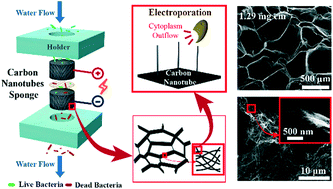Carbon-nanotube sponges enabling highly efficient and reliable cell inactivation by low-voltage electroporation†
Abstract
The recent bloom of nanomaterials has kindled a strong demand for new cell inactivation technology that can replace the conventional cell inactivation process with high throughput, free chemicals usage and outstanding efficacy to all pathogens to overcome the critically global issue, i.e. microbial infection. Herein, we construct a macroscopic carbon nanotube (CNT) sponge using a simple self-assembly method. Based on the technology of 1D nanostructure assisted electroporation, an electroporation disinfection cell (EDC) equipped with CNT sponge achieved superior cell inactivation performance (<0.00001% microbe survival rate) within a contact time of 5 s at an extremely low applied voltage (2 V), trace energy consumption (20 J L−1) and outstanding durability (>60 min). The CNT sponge EDC can be easily powered by batteries or solar cells and shows the best energy consumption performance among all the cell inactivation technologies. Cell inactivation using the CNT sponge EDC has significant potential for practical applications.



 Please wait while we load your content...
Please wait while we load your content...